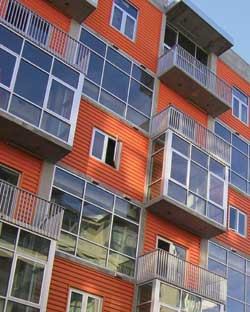It’s All About the View
An outstanding view is the prime reason why most people choose to live in high-rises, particularly urban high-rises, Hamilton says, pointing out that The Cirque’s design was driven by its views of downtown Dallas.
Most of Hanover’s new residential projects are using a lot of glass and stone, Hamilton notes, adding that renters today want floor-to-ceiling glass of 9 feet to 11 feet versus punched windows. “In the past, high-rise buildings had very little fenestration,” he recalls.
Today, many high-rise residential towers use glass curtain walls for their skin. In Chicago, for example, the 49-story Shoreham features floor-to-ceiling glass and vertical bands of exposed concrete with two sets of recessed balconies. The tower, which is part of the 28-acre Lakeshore East development, has views of the Michigan Avenue skyline.
“We wanted to take advantage of the views, so we used highly reflective glass to bring the views into the room,” explains Jim Loewenberg, president of Chicago-based Loewenberg + Architects and NNP Residential & Development, which is developing The Shoreham.
Developers are not only using more glass and including floor-to-ceiling windows, but the ceiling heights are higher, according to Richard Burns, principal with Baltimore-based Design Collective. “Years ago, 8-foot ceilings were standard; today, floor-to-ceiling heights are 10 feet or more, which has had an impact on the outside design,” he says.
Taller ceiling heights and more glass can make a big difference to residents because these features collectively brings more light into units, notes Fred Harris, senior vice president of development for Alexandria, Va.-based AvalonBay Communities. One of the REIT’s newest high-rise projects, Avalon Riverview in Long Island City, N.Y., features corner and bay windows with full-height glass to optimize light and views of the East River and Manhattan skyline.
Developers are also using balconies to bring more light into the interior and to help residents connect to nature even though they live in the sky. “Balconies are becoming another living space,” says John Sheehan, principal of Studio E Architects in San Diego.
